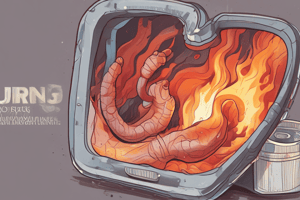Podcast
Questions and Answers
What are the three factors typically used for classifying burns?
What are the three factors typically used for classifying burns?
- Depth, texture, color
- Depth, size, location (correct)
- Thickness, extent, region
- Extent, depth, temperature
Which formula is commonly used to estimate fluid requirements for burn patients over the first 24 hours?
Which formula is commonly used to estimate fluid requirements for burn patients over the first 24 hours?
- Taylor method
- Jones calculation
- Parkland formula (correct)
- Smith equation
What is the primary goal of fluid resuscitation in burn management?
What is the primary goal of fluid resuscitation in burn management?
- Preserving blood flow and preventing shock (correct)
- Promoting skin regeneration
- Preventing infection
- Reducing pain perception
What is involved in wound care for burns?
What is involved in wound care for burns?
Which factor determines the percentage of the body's surface affected by a burn?
Which factor determines the percentage of the body's surface affected by a burn?
What does assessing the severity of a burn involve?
What does assessing the severity of a burn involve?
What is the purpose of applying a topical ointment to a burn wound?
What is the purpose of applying a topical ointment to a burn wound?
Which of the following interventions are used to manage pain in burn patients?
Which of the following interventions are used to manage pain in burn patients?
In burn management, what is essential to prevent hypovolaemic shock?
In burn management, what is essential to prevent hypovolaemic shock?
What advanced techniques may be considered for extensive burns?
What advanced techniques may be considered for extensive burns?
How can infections resulting from compromised skin integrity be treated?
How can infections resulting from compromised skin integrity be treated?
What non-pharmacological approaches can be used for pain relief in burn patients?
What non-pharmacological approaches can be used for pain relief in burn patients?
Flashcards are hidden until you start studying
Study Notes
Burn Management: Assessment, Treatment, and Prevention Strategies
Burn management encompasses a wide range of strategies and treatments aimed at mitigating the severe impacts of burn injuries. From initial assessment and immediate care to ongoing wound management, pain relief, and shock prevention, understanding the nuances of burn care is crucial for healthcare professionals and patients alike.
Assessment of Burn Severity
Assessing the severity of a burn is the first step in managing the condition effectively. Burns are typically classified based on three factors: depth, size, and location. Depth refers to whether the burn penetrates layers of the skin, ranging from superficial (first-degree) to full-thickness (second- and third-degree). Size is determined by the percentage of the body's surface affected (known as %TBSA), and location considers any sensitive areas such as the face, hands, or genitals.
Fluid Resuscitation
Fluid resuscitation is essential for preserving blood flow and preventing hypovolaemic shock. The Parkland formula, which provides an estimate of the fluid requirements over the first 24 hours, is commonly used. However, recent studies suggest that this guideline may not always be the most accurate or efficient method for determining the optimal fluid resuscitation volume, especially for older adults and larger burn sizes.
Wound Care for Burns
Wound care involves cleaning and preparing the burn site to promote healing. Loose skin and blisters are removed, followed by application of a topical ointment to keep the wound moist. Antibiotic therapies may be necessary to treat infections that arise from compromised skin integrity. For extensive burns, advanced techniques like skin grafts or artificial skin substitutes are considered.
Pain Management for Burns
Pain is a common concern for burn patients. It can be managed using analgesics, local anaesthetics, and other interventions designed to minimize distress. Nonsteroidal anti-inflammatory drugs (NSAIDs) and opioids may be prescribed, along with non-pharmacological approaches like distraction techniques and relaxation exercises.
Shock
Preventing hypovolaemic shock is critical during burn management. Appropriate fluid resuscitation and pain control measures help to maintain blood pressure and reduce the risk of complications associated with circulatory instability.
Conclusion
The care of burn patients requires a comprehensive understanding of their unique needs and challenges. By focusing on assessment of severity, appropriate fluid resuscitation, effective wound management strategies, targeted pain relief, and vigilance for shocks, healthcare providers can improve outcomes for those affected by these injuries. Further research will continue to advance our knowledge and capabilities in this field, ultimately benefiting countless individuals whose lives are impacted by burn trauma.
Studying That Suits You
Use AI to generate personalized quizzes and flashcards to suit your learning preferences.




